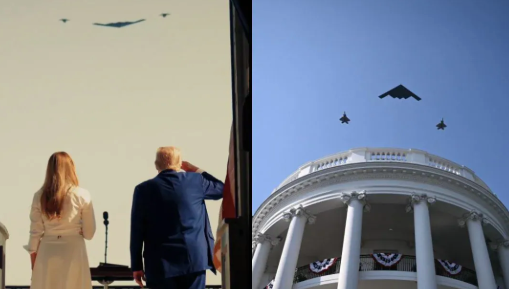On July 4, during the celebration of Independence Day at the White House, President Donald Trump oversaw a dramatic display of U.S. military might. The B-2 bombers flew over the White House as Trump signed the Big Beautiful Bill. Trump, the B-2 Spirit stealth bombers were flanked by F-35s and F-22s thundered overhead as Trump signed his “One Big Beautiful Bill” into law.
Trump signed a $3.4 trillion tax and spending package that extended his tax cuts, increased military outlays, and bolstered immigration enforcement. This legislation is expected to add significantly to the national debt. The legislation is expected to add significantly to the national debt. This was an estimated $3.4 trillion over ten years while scaling back Medicaid and food assistance.
Flying bombers used in real-world strikes with pilots presented for applause underscore American military capabilities. It broadcasts to allies and adversaries alike. Holding the ceremony at the White House South Lawn during a moment of legislative victory serves as a rallying point for the Republican base. They rebranded what many see as fiscally and socially controversial legislation as patriotic and bold.
Trump has leaned into the spectacle to project strength echoing the theatrical “Salute to America” events of July 4, 2019. However, the 2025 edition deliberately emphasizes the warfighters rather than tanks—a pivot in messaging, from domestic hardware displays to elite precision strikes.
Many have viewed this ceremony as inspiring. Military families in attendance reinforced the sense of honor and pride. Opponents argue that blending a partisan victory lap with military demonstrations politicizes the armed forces.
Opponents argue that blending a partisan victory lap with military demonstrations politicizes the armed forces. Some Democrats contend the flyover served as a tactical distraction from the bill’s socially regressive cuts. The optics evoke concerns of a militarized presidency—echoes of authoritarian pageantry—when combined with mass legislative change that disproportionately affects low-income Americans.
The July 4th flyover over the White House combined ceremony, symbolism, and strategy. For Trump and his allies, it was a definitive illustration of American strength, uniting military glory with legislative triumph. To critics, it represented an overreach—a blending of governance, patriotism, and combat that risks eroding democratic norms by framing domestic policy as theater on a geopolitical stage.
At a moment when the U.S. grapples with domestic inequality, global tensions, and concerns over military politicization, this event crystallizes enduring divisions: is it a celebration of soft and hard power fused or an alarming sign of democratic rituals co-opted by spectacle? The roar of B‑2 engines might thrill, but it also reverberates through halls of democracy—with implications far beyond fireworks. Keep Reading Questiqa.us for more news.







Average Rating